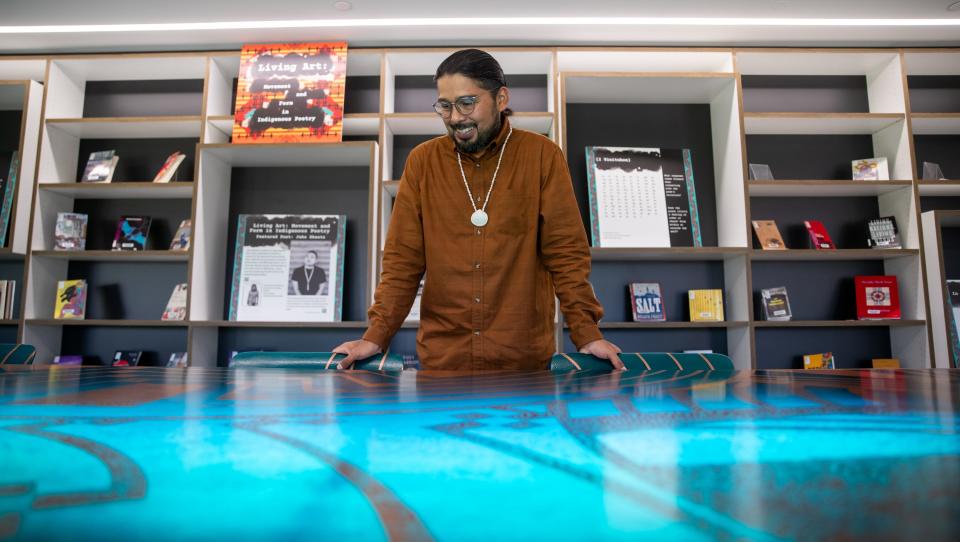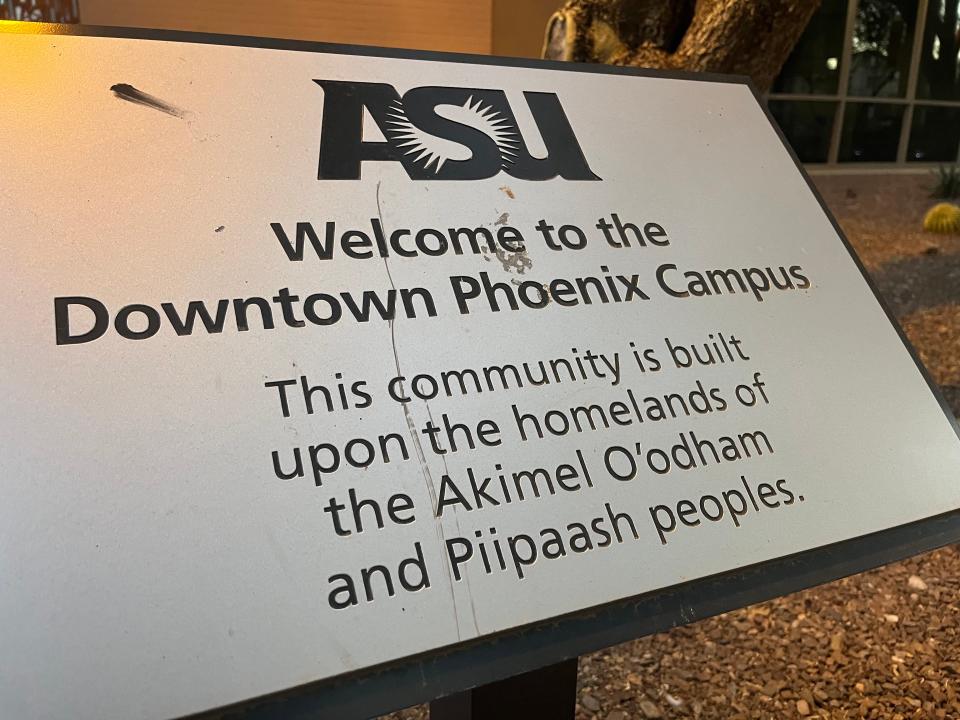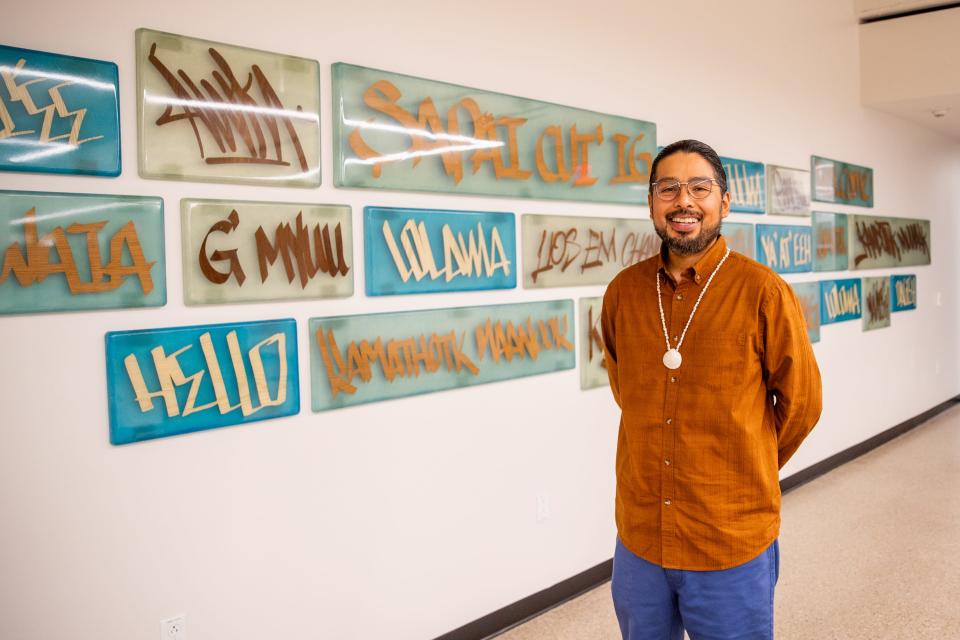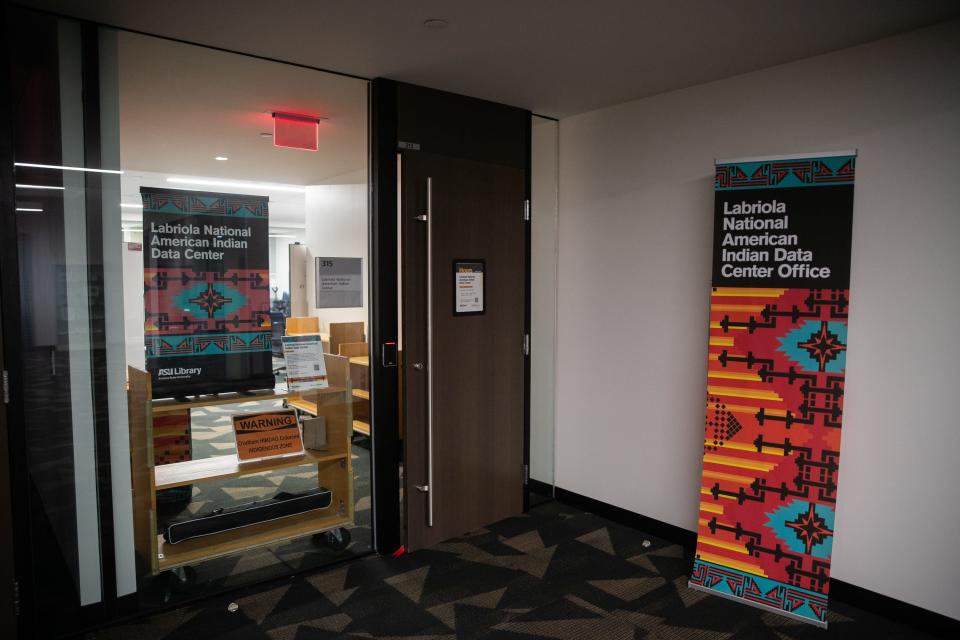Indigenous land acknowledgments are everywhere. Do they accomplish anything?
Indigenous land acknowledgments are everywhere.
After taking hold on college campuses, they are recited with growing frequency at schools, sporting events and church services.
They are added as signatures at the end of emails. They are being posted on the websites of museums, libraries, and other institutions as the era of racial reckoning and social justice that has followed the emergence of the Black Lives Matter movement and the killing of George Floyd continues to evolve.
They are even yelled at concerts, as reggae artist Nattali Rize did during a recent show in Phoenix, drawing loud applause.
Some of the statements are as brief as a single sentence.
"I acknowledge that ASU sits on the ancestral homelands of those American Indian tribes that have inhabited this land for centuries, including the Akimel O'odham (Pima) and Pee Posh (Maricopa) peoples," reads one typical example from an Arizona State University employee email.
Others go on for paragraphs or pages.
Some Indigenous land acknowledgments are uploaded to YouTube. A land acknowledgment video by ASU features tranquil flute music and scenes of flowing rivers and majestic mountains.
They have gained popularity not just in Arizona, home to 22 tribes and more than 310,000 Native Americans, among the largest Native populations in the U.S. The land acknowledgment movement is spreading throughout the U.S., and Native leaders in Arizona are increasingly inundated with calls seeking advice.
Indigenous land acknowledgments are everywhere because everywhere is Indigenous land.

But what exactly are Indigenous land acknowledgments? What do they accomplish? And what do Native people think about them?
In short, Indigenous land acknowledgments are statements that recognize an event or institution is on the pre-colonial homelands of Indigenous people and where Native people continue to live.
They are intended to raise awareness, spark conversation, and encourage people — mostly non-Native people — to learn and reflect upon how they came to be there and acknowledge Indigenous peoples' ongoing claims to colonized lands. They are also aimed at inspiring people to take action to support the betterment of Indigenous communities, experts say.
Are Indigenous land acknowledgments a fad?
Some Native people have mixed feelings about Indigenous land acknowledgments and their recent proliferation.
They are concerned that Indigenous land acknowledgments have turned into a fad and worry they are often scripted, superficial and hollow statements that have more to do with jumping on the "diversity, equity and inclusion" bandwagon than helping Indigenous people regain what was lost through colonialism, conquest, disease, broken treaties, forced assimilation, forced removal and outright theft.
"Most Indigenous people, while appreciative that the general public is learning our names and whose land they are on, are nonetheless skeptical that these statements will progress beyond being performative," wrote David Martinez, a professor of American Indian Studies at Arizona State University, in an email.
"What most Indigenous nations want is their land back, period," said Martinez, who is of the Akimel O'odham and Hia Ced O'odham peoples. "What most institutions that make these statements are willing to offer is far less than that."

To be meaningful, land acknowledgments must be tied to action; otherwise, they become perfunctory, said Jacob Moore, a vice president and special advisor to the president on American Indian affairs at ASU.
"It's one thing to acknowledge, but it's another to do something about it if, in fact, we are tying land acknowledgments to a past that hasn't been fully told," said Moore, who is Lakota/Dakota on his mother's side, and Akimel O'odham/Tohono O'odham on his father's side.
Academic: Some acknowledgments sound like obituaries
Alexander Soto, director of the Labriola National American Indian Data Center at Arizona State University Library, frequently fields calls from institutions in other states asking for help writing Indigenous land acknowledgments.
The first question Soto asks: What will you do beyond recognizing you are on Native land?
"The proof is in the pudding," said Soto, of the Tohono O'odham Nation. Without spelling out the steps an institution plans to take to support Native people, land statements descend into the "whole politics of just recognizing."
Soto said he wants to hear, "How do we now further make visible the people that we have made invisible the past 500-plus years? What are the action steps?"
Indigenous land acknowledgments go wrong when they sound like "obituaries," Soto said.
"You're referring to us in the past tense, you're referring to us like we're long gone, extinct. ... 'We acknowledge the land of these people who used to be here,'" Soto said of problematic acknowledgments.
Land acknowledgments also fall short when they are written from a Google search and are full of inaccuracies obvious to Native people, Soto said.
Expert: Stop romanticizing, acknowledge 'today'
Indigenous land acknowledgments should be crafted with the input of Indigenous communities, not formulated in a vacuum, said Kyle Mitchell, a Diné storyteller and coordinator for the American Indian Intercultural Center at South Mountain Community College in Phoenix.
He worries that without the input of Indigenous communities and an understanding of their modern-day challenges rooted in colonialism, land statements risk promoting a romanticized view of Native people.
For Mitchell, land acknowledgments must avoid perpetuating myths about pre-colonial Indigenous people — like that there were never conflicts between tribes — and recognize the damaging legacy of colonialism. Racism, health disparities and poverty are all linked to post-colonial policies and practices.
"What action is going to show the tribe and the community that you're dedicated to today?" Mitchell said. "By doing that, we're dismantling the romanticizing of Indigenous people. It's no longer like, 'Oh, it's these giant mountains with running water and fish all day.' No, that's where we were. After colonization and assimilation, this is where we are, and we want to be seen as who we are today and respected as who we were and where we came from."

Although he remains skeptical, Martinez, the ASU professor, acknowledged that Indigenous land acknowledgments may serve as conversation starters that could result in change that benefits Native people. He helped the Heard Museum, a world-renowned institute for Native American art in Phoenix, write its Indigenous land acknowledgment and consulted with the Children's Museum of Phoenix on its statement.
"Insofar as institutions like the Heard are willing to acknowledge that it sits on ancestral Akimel O'odham land — complete with installing this recognition in its Home gallery — then that might be leverage, which people like me can use to create more substantial change over time," Martinez said in an email. "Indigenous people are patient. We are not going anywhere."
Why one Mesa school developed an Indigenous land acknowledgment
Darlene Leslie teaches first, second and third grades at the Sirrine Montessori Center, a pre-K-6 elementary school in Chandler that is part of the Mesa Public Schools.
Leslie, who is Hopi and Apache, helped craft and lead a land acknowledgment included in meet-the-teacher night activities for students and parents in August.
The land acknowledgment was intended to raise awareness that the school is located on the homelands of Indigenous people, Leslie said. But it was also aimed at helping make Native American students feel welcome at the school, she said.
The land acknowledgment, she pointed out, also meshes with the Montessori philosophy of emphasizing the interconnectedness between humanity and the land.
"As a Hopi, when we are born, we are taught that we're stewards of the land. We are always protectors of our land, no matter what," Leslie said.
Although not explicitly mentioned during the land acknowledgment, she noted that the struggle by Native Americans to protect ancestral lands is ongoing, something she hopes her students and parents will realize.
"If you look at the (San Carlos) Apache tribe, they are still trying to fight for Oak Flats, which is a sacred ceremonial space they want to make into a copper mine," Leslie said.
Whose land is Phoenix on?
There is a 1,000-year-old platform mound near 44th Street and Washington Street east of downtown Phoenix where the Indigenous Huhugam lived for centuries before the arrival of Europeans.
The Huhugam, archeological evidence indicates, lived in the Phoenix area for 10,000 to 12,000 years, but people may have been living here even longer, said Laurene Montero, the archaeologist for Phoenix.
"They were the ancestors of the O'odham," who say their ancestors have lived in what is now Arizona since time immemorial, Montero said.
The Phoenix area is also the ancestral homeland of the Pee Posh people, who migrated to the region later than the O'odham people, Montero said.

The Gila River Indian Community, south of Phoenix, and the Salt River Pima-Maricopa Indian Community, east of Scottsdale and north of Mesa, comprise people from both the O'odham and Pee Posh tribes. Although their cultures are different, they were put together by the federal government, Montero said.
The pre-colonial Indigenous communities of central Arizona are known for the hundreds of miles of canals they built without metal tools — only wood and stone — and without oxen, Montero said. Despite living in a desert, they were sophisticated farmers, Montero said.
"They built this huge irrigation system that watered tens of thousands of acres," Montero said. "They grew corn, cotton, beans and squash. They also wove cotton."
They also engaged in extensive trade with tribes deep into what is now Mexico, she said.
A museum near the platform mound just east of downtown Phoenix recently adopted its own Indigenous land acknowledgment, Montero said. She said she hopes the acknowledgment will help keep the museum accountable to the O'odham and other Indigenous people of the region.
Once land acknowledgments "are developed and become part of the culture of the agency, I think we kind of have a commitment that we have to stand by. And I think that's not necessarily going to happen until you have that statement," Montero said.
Earlier this year, Montero noted, the city's Parks and Recreation Board voted to change the museum's name from Pueblo Grande to S'edav Va'aki based on recommendations from O'odham cultural leaders. S'edav Va'aki means central platform mound.
Indigenous land acknowledgments started in Canada
Indigenous land acknowledgments began in Canada as part of that country's movement to atone for colonialism's decimation of Indigenous people, said Moore, the ASU vice president. The statements then spread south to the U.S.
"There's been more of a concerted effort from the Canadian government to go through a process of reconciliation," Moore said.
The movement for racial justice in recent years and the inequities exposed by the COVID-19 pandemic, including Native Americans' lack of access to health care and high infection rates, have helped fuel an interest in Indigenous land acknowledgments in the U.S., Moore said.
He credited ASU President Michael Crow with being ahead of the curve when he issued a land acknowledgment letter in 2015, several years before the murder of George Floyd and the pandemic.
Crow's letter makes a commitment to connect with the state's tribal communities and enable the success of Native American students.
"We reaffirm the university's commitment to these goals and acknowledge that everyone, the entire ASU community, is responsible for their achievement," Crow's letter states.
Colleges and universities have long been criticized for failing to recruit and retain Native American students. ASU has shown some improvement, data shows. In 2020, the total enrollment of Native American students at ASU was 3,878, according to data Moore shared. That was up nearly 50% from the 2,619 total Native American student enrollment in 2015 when Crow issued the Indigenous land acknowledgment statement. Despite the gains, Native American students still only made up about 1% of undergraduate students at ASU in 2022 and 1% of graduate students, data shows. That is far below the 5% Native Americans make up of Arizona's population.
There are also now more than 60 Native American faculty at ASU, Moore said. In June, Crow appointed Moore to the new position of special advisor to the president on American Indian Affairs. The role is intended to improve the recruitment and retention of Native American students.
A tangible example of action at ASU
Soto was appointed director of the Labriola National American Indian Data Center in 2021. He is the first Native American to lead the center, created in 1993 as a national repository of Native American documents and materials that can be accessed through computer databases. The center is now staffed by four full-time tenured librarians, including Soto, all Native Americans.
The center on the second floor of the Hayden Library in the middle of ASU's sprawling campus in Tempe is filled with shelves lined with books by Native American authors and scholars. It also features a 25-foot table made of blue fiberglass resin.
During a recent tour, Soto flipped a switch, illuminating from below spectacular curving bands designed to evoke the ancient canals of central Arizona. The table was co-designed by architect Selina Martinez, a member of the Pascua Yaqui Tribe and ASU architecture professor Claudio Vekstein, based on sketches by Jeffrey Fulwilder, a member of the Salt River Pima-Maricopa Indian Community.
The center is going through an expansion. It serves as a tangible example of ASU's growing commitment to Native Americans stemming from land acknowledgment statements, Soto said.
Soto walked through rooms under renovation that will create 5,500 square feet of new study areas, offices for research consultation, space to exhibit the work of local Indigenous artists, and a high-tech stage for poetry readings, talks, musical performances and other live events.
When he attends library conferences around the country, Soto said, librarians from other institutions "are amazed that we have that much support."
Daniel Gonzalez covers race, equity and opportunity. Reach the reporter at daniel.gonzalez@arizonarepublic.com or 602-444-8312.
This article originally appeared on Arizona Republic: What are Indigenous land acknowledgments supposed to accomplish?

